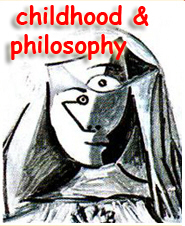affectivity and creativity in philosophy for children
Keywords:
Filosofia para Crianças, Afeto, Criatividade, Pensamento, DiálogoAbstract
Philosophical practice with children allows them to build and (cumulatively) rebuild meanings while they form self-awareness, mobilizing simultaneously elements of affective, cognitive and recreational areas that are present in the sphere of their experience. Within this dynamic, dialogue and thinking skills consolidate upon criticalreflective competences, susceptible to reasonable criteria in the affirmation of intentional interpretative competences of this sensitivity in rich educational private and public environments, such as family and school. Understanding child’s life as a mutual growth process between individual consciousness and the social environment--a way regulated by its value and authenticity as being what it already-is, an «extensive projection» or «embodiment of desire»--Lipman seeks a more attentive, more insightful, more meaningful, more creative and more captivating form of thinking: an investigative thinking. These multiple dimensions of thought provide children with three fundamental exercises in the completion of their uniqueness, character and personality: first, the discovery of their ontological potential manifested by a desire implicit in an inner dialogue with the own intention of knowing themselves as being-subject-child who intends to meet the Other within themselves; secondly, an awareness of the importance of the “relationship between meeting and recognition” with the Other who is no longer a specific identity, but who functions as an imperative to «walk along with… playing» on the condition of assuming reciprocity as a necessity in the construction of a subject who is also faced as a beingperson; and in a third moment, a return to themselves, a way of re-birth as the result of the learning process provided by a specific context. It is in this dynamic context that child learns true thinking. So, thinking better is an exercise, rather than a complex, higher order thought. Inevitably there are concerns that arise in the presence of these ideas: how do we enhance reflective and critical exercises to match this knowledge praxis? What discussion model should we adopt in order to take feelings or ethical impulses, emotions or aesthetic impulses as objects, so that the intimate discovery of children’s own being and their socialization can be effective? What kind of relationship can be established between desire, the art of being and a way of living?Downloads
Published
2015-01-30
How to Cite
bento, fernando. (2015). affectivity and creativity in philosophy for children. Childhood & Philosophy, 10(20), 383–399. Retrieved from https://www.e-publicacoes.uerj.br/childhood/article/view/20684
Issue
Section
articles




